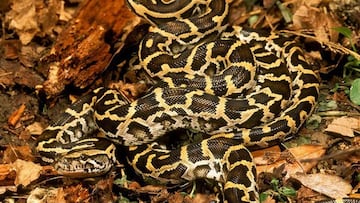Explanation of why the Burmese python can swallow everything
The Burmese python can exceed 18 feet in length and 200 pounds in weight and are capable of submerging for up to 30 minutes before emerging to breathe.

The Burmese python is a solitary animal that can usually only be seen accompanied when it is spring, its mating season. The females lay up to 100 eggs and incubate them for two or three months.
To keep the eggs warm, they continually contract their muscles, never stopping so that the young develop properly. It is among the list of most endangered species due to the great demand for Burmese pythons right now throughout the world.
Also see:
Why the Burmese python snake can swallow whole
Generally, most snakes swallow their prey whole necessitating a wide mouth to accommodate a meal. Unlike the human lower jawbone, snakes do not have theirs connected to the upper portion, allowing the expanded volume of food they can gulp down and the Burmese python is exceptional in this feat.
According to research published in Integrative Organismal Biology journal, birds, goats, deer, coyotes, alligators... none of them are too big for the Burmese python, an invasive and voracious species that has invaded the Everglades in Florida.
Biologists at the University of Cincinnati have discovered just exactly how it manages to swallow such large prey whole, it has developed a unique characteristic that allows it to open its mouth enormously wide.
Scientists compared the abilities of Burmese pythons to those of smaller brown tree snakes. “The stretchy skin between left and right lower jaws is radically different in pythons. Just over 40% of their total gape area on average is from stretchy skin. Even after you correct for their large heads, their gape is enormous,” lead author and UC biology professor Bruce Jayne said.
“It’s intriguing to think about the different potential limits of what animals can do in nature,” the author said. “What does anatomy permit? What does it limit?”
Burmese python in Florida
Introduced to the Everglades (Florida) by the release of captive snakes from the exotic pet trade in the 1970s and 1980s, it is wreaking havoc on the biodiversity of the national park.
It has a super elastic skin between the lower jaws, and with this advantage, the opening capacity is multiplied, being able to swallow almost any animal to satisfy its hunger.
The python doesn’t have good eyesight, so it hunts first using the chemical receptors on its tongue and the heat sensors that cover its jaws. Once the desired animal is located, the reptile uses its teeth (sharp, pointed, and curved backwards) to grasp it, then wraps its long body around it, grasping it with its rings. This cuts off blood circulation and suffocates its prey.





